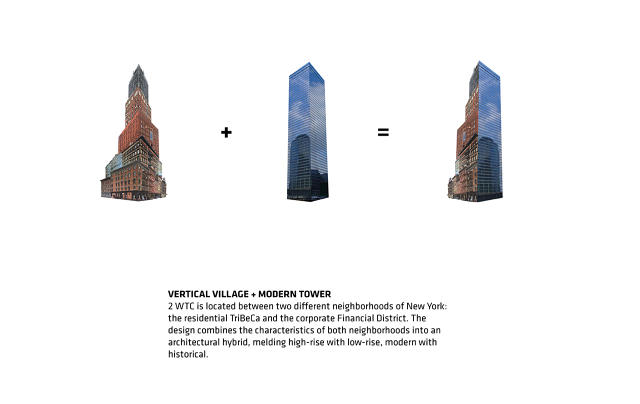After the twin towers toppled on September 11, 2001, it seemed inevitable that two new towers would take their place—a defiant symbol of American resilience. The reality, though, was anything but inevitable. While the first of those towers, One World Trade Center, was completed in 2013, the second tower's development has been at a virtual stall for years.
Earlier this month, The New York Postreported that Danish starchitect Bjarke Ingels would take over the design of Two World Trade Center, replacing the U.K.'s Norman Foster as its lead designer. Now, the Bjarke Ingels Group (BIG) has unveiled the first conceptual designs of what the tower will look like.
Like many of BIG's recent tower designs, Two World Trade Center rises up in tiers, almost like a staircase. The 1,340-foot-tall tower is separated into seven sections, each a little smaller than the one below it. At the base of each tier is a deck, which will be landscaped to evoke varying climates, from tropical to arctic. Ingels describes it to Wired as being "like seven different buildings stacked on top of each other," and the plan is for each tier to be taken up by a different company. Rupert Murdoch's 21st Century Fox and News Corp. will take up headquarters in the bottom two tiers, while the top five will go to smaller, still unnamed tenants.
To me, Ingels's vision for Two World Trade Center looks almost like a neatly stacked pile of puzzle pieces, which seems appropriate: since 2001, the tower's design and construction has been like an unsolvable puzzle.
For years now, Larry Silverstein, the 84-year-old real estate developer who leased the Twin Towers before their destruction, has been trying to get Two World Trade Center built. He commissioned Foster back when it was believed that the anchor tenant of 2 WTC would be a bank. But as Manhattan's Financial District has been taken over by Internet and media companies, the 80-year-old British architect's design has increasingly looked out of touch. When News Corp. signed on as 2 WTC's new anchor tenant, they brought in Ingels (co-designer along with Thomas Heatherwick of the new proposed Googleplex) to give it a fresh look.

Ingels has his work cut out for him to get his vision of 2 WTC built. Because of the complexities of the World Trade Center's redevelopment, Ingels will have to retrofit his design to foundations already constructed by the Port Authority for the shopping mall located beneath the site. And as Wiredrightly notes, "Ingels will have to perform his craft on a scale—in terms of height, cost, and the degree of public scrutiny—unlike anything he has encountered before." Just look at what happened with One World Trade Center.
But maybe it's that public scrutiny that BIG should fear most. The wounds of 9/11 are still fresh. Is a tower that looks like it's slightly leaning to one side really what New Yorkers want on the site of the World Trade Center's destruction?
Read more about BIG's redesign of 2 WTC here.